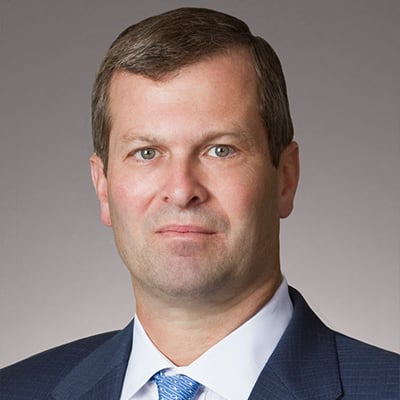Practice Makes Perfect for These Hot Litigators
For those litigators who live in the courtroom and for courtroom victories — however ephemeral — 2007 brought multiple big plaintiffs' verdicts.
Whether one looks at Chris Searcy's personal injury firm in Florida, which won four verdicts totaling more than $101 million, or considers that corporate defender Kirkland & Ellis chalked up three large plaintiffs' verdicts, it was a big year for compound victories. Kirkland had a fourth big case, but it was a $45.3 million loss in a patent infringement case it defended.
It's not uncommon to have multiple high-stakes trials occurring simultaneously, said Jay Lefkowitz, partner and management committee member at Chicago-based Kirkland, where litigators generate half of the firm's revenues.
What was different in 2007, said Gene Assaf, lead plaintiff's lawyer in one of Kirkland's big wins, is that while staunchly defending cases, the firm has picked up a few of its opponents' tricks of the trade.
It's "no fluke" that Kirkland had three big plaintiffs' verdicts totaling nearly $1.9 billion last year, said Assaf. He represented BASF Corp., which a New Jersey jury awarded $170 million in a breach of contract case. BASF Corp. v. Lyondell Chemical Co., No. MRS-001069-05 (Morris Co., N.J., Super. Ct. 2007).
"I think by doing defense cases you have to think how to put on a successful plaintiff's case," said Assaf, who in 2006 played the role of the plaintiff's lawyer in mock trials preparing for a big defense case tried in Florida.
The lead defense lawyer in the BASF case, Lee Godfrey of Susman Godfrey in Houston, did not return a call seeking comment.
Another factor fueling multiple verdicts was the economics of the insurance industry. Insurers have been more interested in litigating than settling the high-dollar cases, to delay payout, said Searcy of Searcy Denney Scarola Barnhart & Shipley in West Palm Beach, Fla., which posted a record four 8-digit verdicts.
"I was on trial a lot in 2007," said Searcy, who tried all four cases with help from partners. "When the defendant will pay top dollar on a case, we settle. When they won't, then we try them." Defense lawyers in two of Searcy's cases, Mark Haskins of Lupin & Haskins in Sarasota, Fla., and William V. Johnson of Johnson & Bell in Chicago, did not return calls.
Insurance market conditions or litigation techniques notwithstanding, what put firms in the multiple-verdict category was clear: Trying cases. Lots of them. Kirkland & Ellis, with 1,300 lawyers, can carry multiple trials, but so can 14-lawyer Cunningham, Bounds, Crowder, Brown & Breedlove in Mobile, Ala., which had two big plaintiffs' verdicts last year: a $50 million award stemming from a water heater valve that leaked natural gas, causing an explosion, and a $108 million verdict from dumping hazardous waste containing mercury.
"If you're just occasionally trying cases and occasionally putting your team together to go to trial, it's going to be a lot more difficult in my view than if you do it all the time," said Robert T. Cunningham, lead trial lawyer in the environmental case, which involved a Halliburton Corp. joint venture. "It's like the people who do a certain type of surgery and do it over and over. If you are doing it regularly, you are better at it."
'Zap!' goes the verdict
Cunningham is no neophyte in winning big verdicts. In 2003, his firm won the year's top jury verdict, as recorded by NLJ affiliate VerdictSearch. That was the record-setting $11.9 billion fraud case against Exxon Mobil Corp. over oil and gas royalties payable to the state of Alabama. (The trial judge reduced the award to $3.2 billion.) The landmark verdict recently was struck down by the Alabama Supreme Court, which reversed the jury's fraud finding and reduced the damages to $52 million.
The Supreme Court ruling came just hours after Cunningham won the verdict in the Halliburton case. "Basically you think you've had a great day, and then, zap! You are $3.4 billion in the hole," he said. "Appellate judges these days are like David Copperfield. They can make a gigantic jury verdict evaporate into thin air very easily, so you have to do everything possible to avoid that."
Cunningham expects a vigorous appellate challenge in the Halliburton case. His client, which owns an unlined, non-hazardous waste landfill, sued Houston-based Halliburton Corp. and ShawCor Ltd. of Toronto, which operated a joint venture pipe-coating plant that applied an insulating material called GSPU on the exterior of undersea oil and gas pipes. For two years, the company deposited 260 tons of GSPU in barrels in the plaintiff's 200-acre landfill without disclosing that the material, which covered 20 acres, contained hazardous mercury. Dirt Inc. v. ShawCor Ltd., No. V-05-001523 (Mobile Co., Ala., Cir. Ct. 2007).
Cunningham had to do an end-run around Alabama environmental law to get past summary judgment. The law limits recoveries in dumping cases to the fair market value of the property — regardless of the cost of the cleanup, he said. In this case, the figure was $17,000. Meanwhile, the plaintiff's engineers estimated a multimillion-dollar cleanup tab.
Fighting case law, Cunningham argued that his case was an exception to the rule because Alabama environmental officials had ordered the removal of the hazardous material. The judge agreed, and the jury held the defendants liable, awarding the plaintiff $108 million, including $8 million in punitive damages.
The lead defense lawyer in the case, Donald E. Godwin of Godwin Pappas Ronquillo in Houston, didn't return a call seeking comment.
At trial, the plaintiff's lawyers used a defense prop to the plaintiff's advantage. Defense lawyers showed the jury a hardened block of GSPU to demonstrate that the substance was unlikely to deteriorate and cause mercury to leach out, Cunningham said.
"It was pretty and yellow and nice and neat," he said. A defense lawyer banged the GSPU block on the jury box and passed it to the jury.
"We let him do that for about three days," Cunningham said. "He did not know that we had dug up a sample."
During cross-examination of a defense witness, the plaintiff's lawyer pulled out a plastic bag containing the clearly deteriorated GSPU that had been underground for a few years.
"It was mushy and gooshy, and you could squeeze it like a sponge," he said.
Like Cunningham, lawyers at Fenwick & West of Mountain View, Calif. — who won two large patent infringement jury verdicts for their plaintiff clients in 2007 — have tasted sweet yet fleeting jury wins.
In a decade-long case, a federal jury in San Jose, Calif., awarded $74.7 million to Fenwick client Asyst Technologies Inc., which holds a patent for a portable computer that tracks silicon wafers during manufacturing to minimize defects. Asyst alleged that its patent was infringed by Emtrak Inc., Jenoptik A.G. and other companies that marketed a competing wafer-tracking device. Twice the trial judge granted the defense summary judgment and twice that ruling was reversed on appeal and the case remanded for trial. The jury awarded Asyst damages for price erosion and lost profits.
However, the trial judge granted the defense a judgment as a matter of law, nullifying the jury finding and awar d. Asyst Technologies Inc. v. Emtrak Inc., No. 98-20451 JF (N.D. Calif. 2007).
Lead plaintiff's trial counsel, Darryl M. Woo, has filed an appeal. "There is substantial evidence to support the jury's findings and I think the jury's verdict should be respected," said Woo, who heads Fenwick's 80-lawyer litigation team. He said the jury rejected the defense argument that the patent was invalid because the technology was obvious. Woo said the technology may seem old-hat now, but it was novel when developed in the late 1980s — a time when cellphones were expensive and the size of bricks, and laptop computers as big as sewing machines.
"To put the jury back in the right time frame was a challenge," said Woo, who used a partner's vintage cellphone and a Polaroid instant camera as props. "Once we got the jury to focus on the right question, then I think it was easy for them to come to the right answer that the patent was valid."
The plaintiff "sent the jury down the wrong path," said lead trial defender Floyd R. Nation of Washington's Howrey. "They stretched their patent too far" to try to cover the defendant's device, he said. "I think the judge saw that immediately and knew that they were confused."
REPRINTED WITH PERMISSION FROM THE FEBRUARY 18, 2009 EDITION OF THE NATIONAL LAW JOURNAL © 2009 ALM. ALL RIGHTS RESERVED. FURTHER DUPLICATION WITHOUT PERMISSION IS PROHIBITED


